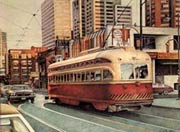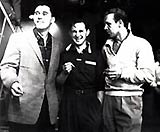 |
|
St. Lawrence Hall, 1855 |
Modern Toronto is the undisputed centre of English language Canadian culture and entertainment. The city's first recorded show is a performance of "School of Scandal", by a visiting New York Troupe in 1809. But culture is slow in getting established.
It isn't until 1837 that York erects a grand theatrical venue; Theatre Royale. Thirteen years later Massey Hall is built, followed by St. Lawrence Hall. In 1907, the Royal Alex is hoisted up and rescued from neglect in 1962 by "Honest" Ed Mirvish. It is the largesse of the well-to-to, who are doing very well, that helps establish theatre and launches local careers. In 1898 a future super star makes her debut on a Toronto stage - five year old Gladys Smith, later known as Mary Pickford.
Art galleries come into vogue in 1834 when the Toronto Society of Artists attracts attention with an exhibit of Paul Kane's nature paintings. Unfortunately, the cholera epidemic keeps the crowds away. Many of Kane's paintings are now housed in the Royal Ontario Museum, which opens its doors in 1914. In 1910, Boulton's old home, "The Grange" becomes an art gallery. Ten years later, the Toronto art scene is shaken awake by the Group of Seven, who make their world premier at the 1920 opening of the Art Gallery of Toronto.
In 1867, Toronto teacher Alex Muir, pens Canada's national anthem, The Maple Leaf Forever. A hundred years later, another Torontonian, Glenn Gould, amazes the world with his musical prowess. Through the 1920, 30s and 40s, Toronto is hopping with all the Big Bands.
Classical arts emerge with the opening of the Conservatory of Music in 1887 and the establishment of the TSO in 1908. The National Ballet appears on the scene in 1951, while the more popular Burlesque shows have been running at the Victory and Gaiety since the turn of the century.
 |
 |
 |
|
Betty Oliphant leads a 1955 class of future balerinas
|
Brush Strokes on Dundas Street, 1979
|
Frank Peppiat, Norman Jewison and Wally Koster
|
By the 1960s, film and television are the medium, engaging the talents of artists. Toronto is Canada's undisputed production centre. CBLT begins television broadcasting in 1952. In 1960, CFTO becomes the first private broadcaster in Toronto, growing into CTV, the first and largest private television network in the country. Alliance and Atlantis set up shop in the 1970s, producing movies and series for and about Canadians. In 1975, The Toronto Film Festival begins - a first rate venue that will become the second most important film festival in the world. Canada's famous Hollywood director, Norman Jewison comes home to establish the Canadian Centre for Advanced Film Studies (Now The Canadian Film Centre) in 1988. Meanwhile, the city of Toronto is standing in for American locations as US filmmakers take advantage of our fluctuating dollar.
Next: Pop Culture
|
